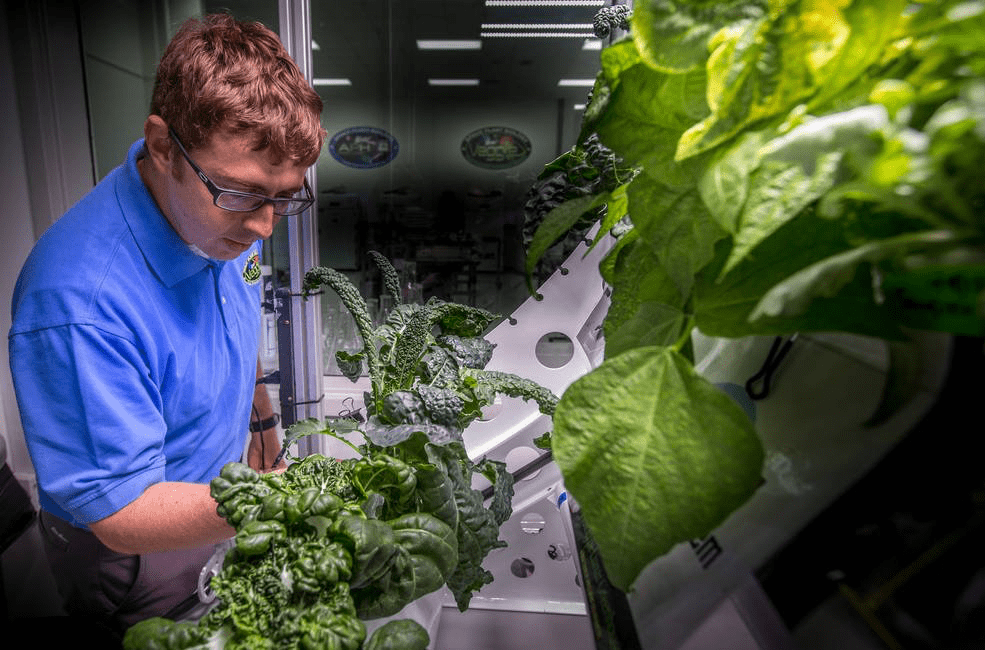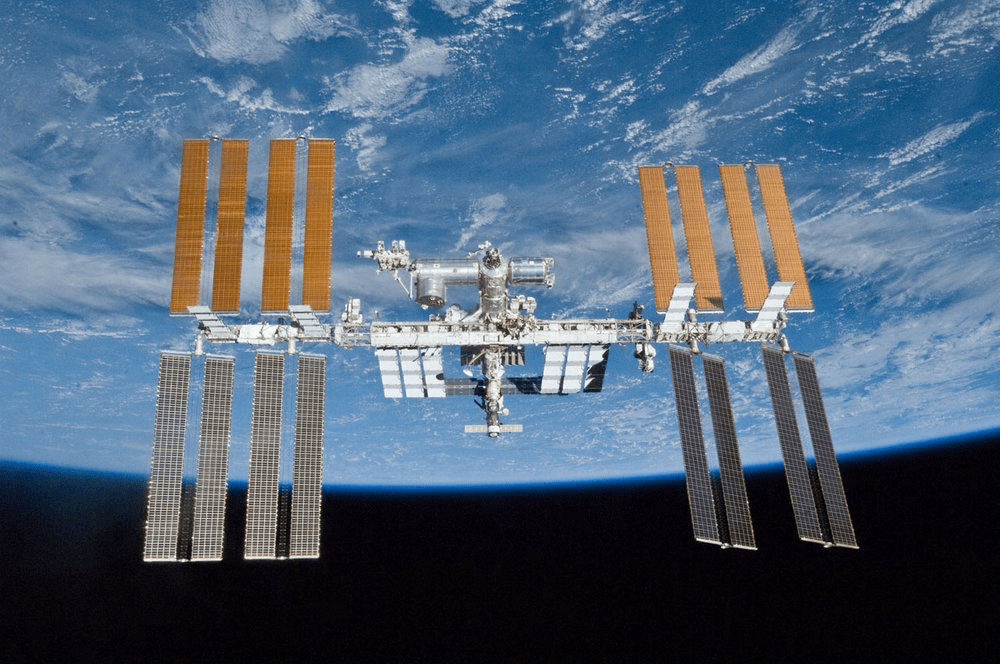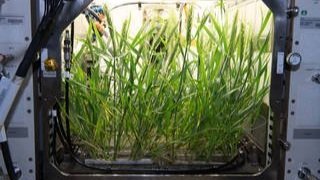May 23, 2022
Farming In Space: The Future Of Indoor Farming Is Unfolding Aboard The International Space Station

NASA's Matt Romeyn works in the Crop Food Production Research Area of the Space Station Processing Facility at the agency's Kennedy Space Center in Florida; image sourced from NASA/Cory Huston
Editor’s Note: The much-awaited Indoor AgTech Innovation Summit will gather the indoor agtech community together in New York from June 23-24, 2022. As part of our promotions, Agritecture interviewed panelists joining from the International Space Station National Laboratory - Christine M. Kretz, VP of Programs and Partnerships, Mounir Alafrangy, Commercial Innovation Manager & Technology Lead, and Patrick O'Neill, Public Affairs and Outreach Lead. Register for the event HERE, and use discount code AGT10 to receive 10% off in-person or virtual delegate passes.
The future of R&D for the controlled environment agriculture industry has arrived — and it’s in space.
Space farming has been a topic of interest to astronauts for nearly as long as humans have been in space. With each individual astronaut requiring about "1.8 kilograms of food and packaging per day,” supplying nutritious food to space stations and other long-duration missions is heavy and resource-intensive work.
The field has seen particularly rapid interest and development in the past few years. Some of this research, mainly that carried out by NASA, is focused on the best ways to feed astronauts while they are conducting missions in space. But, there is another strand that is seeking to further CEA research in space with the specific goal of informing agricultural practices here on Earth.

The International Space Station; image sourced from NASA
The team with the International Space Station (ISS) National Laboratory is tapping into this type of research to build agricultural resilience for those of us on Earth.
While the general public might have some skepticism about the efficacy of conducting agricultural R&D in space, the benefits of space-based farming research for terrestrial purposes are multifaceted. Its main asset lies in the uniquely constant environment provided by zones of very low-level gravity, or microgravity. As Mounir Alafrangy, Commercial Innovation Manager & Technology Lead with the ISS National Lab explains: “That constant microgravity allows researchers to look at the plant biology and at matters that they simply can't do here on Earth. We can try to simulate microgravity, but we're not very successful at doing that. And when we actually accomplish it, it's only for a few minutes.”
So, by developing ways of growing plants in conditions of microgravity, researchers are ultimately looking for ways to improve efficiency and sustainability for our own methods of growing food on Earth. By working within an environment which does not have natural access to the same resources that plants require on Earth (sunlight, soil, space, water), “the technology that is built for space-based farming is unique for that harshness in the environment.”
Alafrangy elaborates that, “once we have hit specific milestones, we reintroduce the gravity in certain situations to make this [suitable] for terrestrial use. And the goal is to build a system that is more efficient, more reusable, occupies less space, uses less water, and less energy to get it to thrive. All these systems eventually aid in making indoor farming more sustainable, yet just as effective.”

NASA astronaut Scott Tingle with the VEGGIE facility aboard the International Space Station; image sourced from NASA
The key to achieving this level of efficiency is the extreme lack of resources inherent in a microgravity environment.
Alafrangy adds that in space, “you don't have the luxury of trial and error. You can’t throw a lot of energy, fertilizer, or sunlight at a problem and think that will fix it. You can't afford that. So you have to be very precise. And that technology will hopefully eventually transfer back to how we farm today.”
“When you’re confined, you’ve got limited resources. You’re forced to innovate in order to survive. ”
Christine M. Kretz, VP of Programs and Partnerships for the ISS National Lab, elaborates by drawing links between the kinds of problems indoor farmers commonly tackle on Earth, and the issues faced when growing crops in microgravity. “How do we make the most of limited space? Can we do this in the warehouse? And get capacity out of this? How do we make the lights work to make the produce grow the best?”
Research onboard the ISS is helping to find answers to these questions to better serve indoor farmers on Earth.

The VEGGIE facility aboard the International Space Station growing lettuce; image sourced from Sierra Space
In terms of the role of space-based research in improving the sustainability of the agricultural field, Kretz mentions the unique insights scientists can gain through data collected from space. The International Space Station "can see 90% of the planet as it passes over. So insights from what's happening on the planet, and weather conditions, get recorded from the Space Station as a unique satellite that flies over much of the planet. That data is very useful, and can help us with long term insights into climate change.”
In the future, the ISS National Lab envisions a continued focus on figuring out how to maximize growing efficiency while using minimal space. Kretz explains that “our mission here at the ISS National Lab is to enable a robust and sustainable market, and things are moving pretty fast. And this is part of helping to ensure that we build the demand in areas like plant biology, and agriculturally inclined investigations. So it looks like we're getting pretty positive outlooks for the future.”
You can join this year’s ISS Research and Development Conference happening in-person from July 25-28 in Washington, D.C. to learn more about the ISS’ sustainability and plant biology research.
Here are some examples of the innovative tech aboard the ISS and the projects it’s facilitating:

CubeLabs is an automated hardware platform manufactured by Space Tango, which are used for iterative R&D projects on the ISS. One company using this hardware to test out new agricultural methods in space is Budweiser: they are looking at ways to germinate barley for beer in microgravity conditions.
While part of Budweiser’s aim is linked to the aspiration to get to Mars, with a view to bring human comforts like beer to new planets, the ISS National Lab is interested in funding the project more so for the R&D potential they see it having for farmers on Earth.
“The knowledge that they could gain by looking at things like barley in Low Earth Orbit could be advantageous for the general agricultural community. They could also help to influence how it is that we cultivate barley here on Earth.” - Patrick O'Neill, Public Affairs and Outreach Lead
*Image sourced from Space Tango Facilitates.

The Cotton project, sponsored by American big box department store chain Target, focuses on germinating plants in space with a mission of improving their sustainability. Specifically, scientists are conducting genomic experimentation to improve the tolerance of cotton crops to drought and other harsh climate conditions.
This project is ongoing, and its sustainability findings will eventually be published and continue to inform more phases of similar research.
“What's good about [this project] is that it's not a company that's keeping it to themselves. It's university-based: they have findings that they're going to publish, and they're also going to prepare and submit a project for phase two. So they're going to continue this research. And we're excited to see what else they'll find.” - Christine M. Kretz, VP of Programs and Partnerships

Sierra Space Plant Facilities
Aerospace company Sierra Space built the two plant facilities currently on the ISS. They are involved in various on-board projects, such as the vegetable production system, or “space garden,” Veggie. Patrick O'Neill comments that, “the Veggie platform is very interesting, just from its own capability. Recently, NASA grew some things like peppers on it, and different kinds of vegetables that are harder to grow, other than just lettuce.”
Sierra Space has also worked on the Advanced Plant Habitat, which is cultivating more complex vegetable varieties on the ISS, such as chile peppers. Lastly, they are involved in the XROOTS experiment (eXposed Root On-Orbit Test System), which makes use of hydroponic and aeroponic methods to be able to grow plants without any soil or growth media, whose growth scientists can observe and track from Earth.
*Image sourced from NASA.
Luckily, there are plenty of ways for interested parties such as engineers or scientists to get involved with ISS National Lab research projects. Currently, there are several options open for ISS National Lab Research project submissions. These include calls for projects to promote K-12 digital engagement in STEM, projects regarding advanced materials and manufacturing, and the Technology in Space Prize. Once again, the crux of any successful project submission to the ISS National Lab must be rooted in their potential for terrestrial application. Other than through awards, interested parties can fund their R&D research to take place aboard the ISS, for instance, with a financial partnership from a corporate sponsor.


